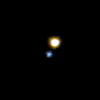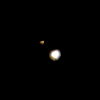


Little Gems of the Night Sky
(Some Easy-to-Observe Colourful Double Stars)
People often have difficulties in seeing the colours of stars. I read somewhere that 5 to 10% of males are colour blind to some extent, ie. are colour-perception impaired, including yours truly. It seems that the colour vision gene is carried by the X-chromosome, and since men have XY while women have XX, any deficiencies in one X is often fixed by the other X in females. The consequence is that colour blindness is very rare amongst women. Full green/red colour blindness is also very rare, ie. people who cannot distinguish a red traffic light from a green, except by their relative positions. That's why traffic lights are all placed in the same relative positions internationally. This little piece of information was passed to me by one of these very rare, fully colour blind men, an English colleague. Of all coincidences, the only other person I have ever come across who was similarly colour blind was his Indian assistant. The odds against these two ending up together are immense. You can imagine that they indeed had some unique challenges when preparing presentation slides... With just a cursory glance, the stars all seem to be bright gold/white. Nevertheless careful observation by eye does reveal the more strongly coloured ones, like Betelgeuse (orange) and Rigel (blue-white). The colours become more obvious in binoculars and in telescopes. These optical aids increase the brightness and thus there's more light to excite the colour receptors in our eyes. The colours become much more obvious in binoculars when the pair making up a close double star have contrasting colours (ie. a pair of stars that are so close together that they appear as one to the unaided eye). This page examines the colours of a few doubles. All the photos were taken with a Canon EOS D30 digital camera, with the white balance set to "daylight". The colours should thus be fairly accurate, provided the stars were close to the zenith when the photos were taken. As the stars set towards the horizon they tend to go brownish (like a setting Moon). Except for Eta Cassiopeiae (rather north to get it close to the zenith in Oman) all the pairs were photographed reasonably close to the zenith, so the colours should be close to "reality". Let us start with the "Scout Double", Alberio, the head of the swan in Cygnus, also known as Beta Cygni. This is a very popular double, easily split in a pair of binoculars and the blue and gold colours contrast magnificently:
Alberio, Beta Cygni
Magnitudes 3.1+5.1, 34 arc-seconds separation



This is a bright double, hence quite easy to locate even in a light polluted sky, and the pair has quite a large separation, an easy split even in low-powered binoculars. Presumably that's why it's popular at star parties and amongst boy-scouts :-) I sampled the colours of the two stars in an image editor and created the swatches next to the photo, so it becomes easier to appreciate just how much they differ. The size of each star image depends on how bright it is, a product of the photography, not a reflection of their relative physical sizes. Just for the record, for the astrophoto nerds, the star photos were all taken at ISO 1600 with a Celestron Ultima 2000-8" using eyepiece projection at about f/33 (Focal Length around 6600mm). I deliberately set the configuration for over-sampling, rather than "critical" at the Nyquist criterion, so that the Bayer colour filter array on the sensor does not interfere with the output colours. Each photo is a composite of between 2 and 8 captures, again to ensure better colour sampling. Exposures varied between 1/8 sec and one sec, depending on the pair. Capture was by RAW, converted to 48-bit files with White Balance on "Daylight", Colour Saturation "High", other parameters "Normal". Here's another bright double with contrasting colours:
Almach, Gamma Andromedae
Magnitudes 2.3+5.5, 10 arc-seconds



Here is a double with a green (!) component, rather unusual:
Gamma Delphini
Magnitudes 4.5+5.5, 10 arc-seconds



OK, we have all read somewhere or other that you cannot have a green coloured star. Stars are supposed to emit a black body radiation (ie. with colours ranging from red to orange to yellow to blue. Somewhere between the cold red stars and the really hot blue ones you get something that looks white (or yellow), like our sun. Explanations have been put that spurious colours like green or purple are optical illusions created in our brains. Well, I am tempted to say hogwash! The star above photographs green, nothing to do with an optical illusion in my head! I propose that one possible explanation could be that the green member is in fact an unresolved doublet in itself, with a blue and an orange member. At certain relative brightness ratios the combination would look (and photograph) green. I tried this out by compositing an orange swatch and a turquoise-blue swatch (both "acceptable" colours for black body radiation) in an image editor, and you do end up with a green of a similar tint to the above by playing around with the relative ratios. If the doublet is an eclipsing variable it would even photograph as different colours depending on the relative positions of its members, varying all the way from orange through yellow, green to blue. Purple is also easy to create from a hypothetical doublet made up of red and blue stars. Of course, not all doubles have contrasting colours. The one below is found in the "W" of Cassiopeia:
Eta Cassiopeiae
Magnitudes 3.4+7.5, 12 arc-seconds



The strong brownish tint could also have been enhanced by the fact that when I photographed the pair it was some 42 degrees away from the zenith. Perhaps. One very popular double star is the famous Double Double in Lyra, Epsilon Lyrae. This "star" has four components, split into two pairs. At a light polluted site, like my rooftop, all the four stars together may still be too faint to see, despite being very easy to locate because of their proximity to Vega. At a dark sky site, with nice, steady seeing, it is possible to make out a double star with the unaided eye. That's the 208 arc-second separation between the two pairs. Each of the pairs is quite tight and cannot be split in moderate power binoculars. Stars may seem close together from our point of view but may also be at enormously different distances from us. In such cases the double star may be nothing more than a happenstance of our viewpoint. Nevertheless the four stars of Epsilon Lyrae are at about the same distance from Earth and are suspected to form one system, orbiting each other somehow. I was keen to check out whether these four stars have different colours. Visually, through a telescope eyepiece to me they all looked the usual gold-white, turns out they are all blue(turquoise)-white:
Double Double, Epsilon Lyrae
Magnitudes 6.1+5.0 + 5.2+5.5, 208 arc-seconds, 2.6, 2.3





I hope the above has whetted someone's interest in checking out these and the other thousands of double stars. Anyone can do it using a star chart and a standard pair of binoculars, or a small telescope, and from any light polluted site :-) For a list of 100 of the more popular doubles click here. If you are male and wish to check your colour blindness/impairment click here. It might explain why your partner thinks you have rather weird colour tastes...
For other stuff (eg. normal photography) return to Samir's Home
To drop me an e-mail just
click on:
samirkharusi